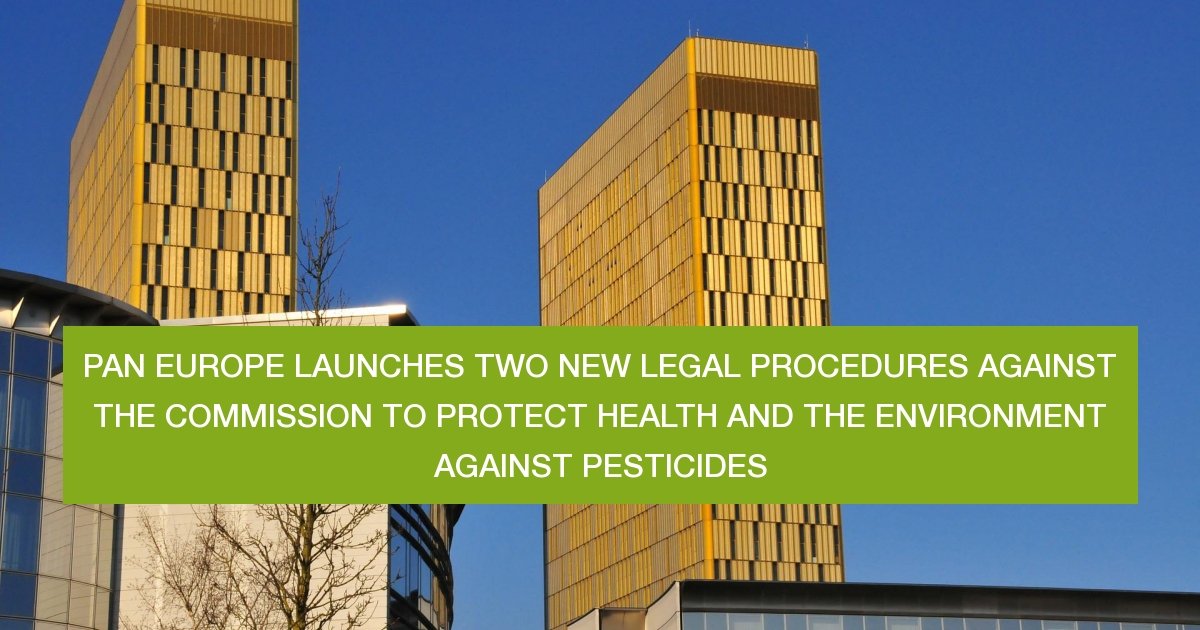DG Sante and EU Member States keep taking decisions that support the use of harmful pesticides. This is a violation of the EU pesticides legislation, the provisions of which aim to ensure a high level of protection for humans, animals and the environment. To address this maladministration PAN Europe filed 2 requests to the Commission to review its decisions. One concerns the new regulation on the identification of unacceptable co-formulants and the other concerns the Commission practice to keep approving highly toxic pesticides in greenhouses.
Martin Dermine, executive director at PAN Europe said: "Decisions from DG Sante and Member States keep disregarding the provisions of the pesticide regulation[1], despite the promises of the Green Deal. We observe that instead of giving precedence to citizens' health and the environment, the Commission keeps favouring the interests of the agro-industry. Maintaining the presence of highly toxic pesticides in our environment, including on our food, goes against the signals regularly sent by citizens".
PAN Europe has submitted a request for internal review on the active substance Abamectin, a highly toxic acaricide, that was recently re-approved for use in greenhouses[2].
Manon Rouby, a legal adviser at PAN Europe said "The Commission re-approved abamectin, on the theoretical assumption that greenhouses are closed systems that prevent any release of abamectin in the environment. PAN Europe challenges this approach as the Commission is well aware that greenhouses are leaking and that environmental contamination is inevitable".
The Commission's own scientific agency, EFSA, indicated that greenhouses in reality are not closed systems[3] and that abamectin presented a high risk to the environment, even when used in greenhouses[4]. Yet, the Commission decided not to follow its own scientific agency's opinion. Furthermore, 2 guidance documents, from the Commission itself, confirm that greenhouses do not prevent the emission of pesticides into the environment[5].
Hans Muilerman, a chemical officer at PAN Europe added: "The EFSA had also warned the Commission that consumers' protection against abamectin could not be ensured, but the Commission seems to have turned a blind eye and decided to re-approve this pesticide. With this action, we are asking the Commission to close this old loophole and finally accept to truly ban toxic pesticides instead of maintaining them on the market."
Request for review of weak regulation for co-formulants
PAN Europe sent a second request for internal review concerning the recent regulation[6] defining a procedure to identify unacceptable pesticide co-formulants[7]. Co-formulants are chemicals added to pesticide products, other than the active substance, to increase their toxicity and effectiveness. They can represent up to more than 50% of the composition of a pesticide. The pesticide regulation requires the same level of protection from co-formulants as from active substances. Yet, co-formulants are still not assessed thoroughly for their toxicity. For many of them, public authorities have no data at all on their toxicity. This is of concern, since citizens are exposed to them, through residues in food, water and the environment. The European Commission recently published a regulation presumably meant to better regulate co-formulants and ban those identified as unacceptable from products’ composition.
Martin Dermine said: "This new regulation is a smoke screen. It questions the aims of DG Sante, whether these are to reduce the burden for the pesticide industry or to protect citizens and the environment from potential harm as required by the EU law. The way this regulation has been written prevents regulatory authorities from identifying toxic co-formulants. Citizens and the environment will remain unprotected".
PAN Europe had already alerted the Commission[8] that their draft regulation would not ensure the same level of protection for citizens' health and the environment as for active substances, as requested by the pesticide regulation1. Indeed, with this regulation, the European Commission is asking Member States to identify co-formulants that would harm people's health or the environment, but without obliging the pesticide industry to provide the necessary toxicity assessment data. In fact, there are still no harmonised data requirements for co-formulants and therefore the safety assessment of these pesticide ingredients remains insufficient. Furthermore, the Commission imposes that the 27 Member States carry out 27 times the same risk assessment for co-formulants, instead of centralising it at EU-level (EFSA).
Salomé Roynel, a policy officer at PAN Europe further explains: "During the public consultation, a series of NGOs and scientists highlighted the weaknesses of the proposal. Without the necessary data to identify toxic co-formulants, how can Member States do their job? Scientific evidence shows that many co-formulants are toxic to bees, to aquatic life, or are carcinogenic, mutagenic or toxic to reproduction substances. These are dangerous substances and they should be thoroughly risk-assessed. During the public consultation, only one stakeholder congratulated the Commission for their proposal: CropLife Europe[9]".
Background information
The pesticide regulation1 (article 27) imposes that co-formulants should not have any effect on human health and no unacceptable effect on the environment, as active substances. In 2021, the European Commission, following a non-transparent procedure, has set a list of unacceptable co-formulants.
In the frame of the discussion on this new regulation, PAN Europe has published a position paper on co-formulants and a factsheet.
Contacts:
- Martin Dermine - martin [at] pan-europe.info - +32 486 32 99 92
- Angeliky Lysimachou - angeliki [at] pan-europe.info - +32 496 39 29 30
Notes:
[1] Regulation (EU) 1107/2009
[2] https://eur-lex.europa.eu/legal-content/EN/TXT/?uri=CELEX%3A32023R0515&q...
[3] https://www.efsa.europa.eu/en/efsajournal/pub/3615
[4] https://efsa.onlinelibrary.wiley.com/doi/full/10.2903/j.efsa.2022.7544
[5] https://food.ec.europa.eu/system/files/2016-10/pesticides_ppp_app-proc_g...
https://food.ec.europa.eu/system/files/2017-02/adv-grp_wg_20150625_tech-...
[6] https://eur-lex.europa.eu/legal-content/EN/TXT/?uri=CELEX%3A32023R0574&q...
[7] A co-formulant is a chemical that is added to a pesticide active substance (e.g. "glyphosate") to increase its toxicity. For more information, please refer to PAN Europe's factsheet on co-formulants
[8] https://www.pan-europe.info/resources/briefings/2022/11/position-paper-i...
[9] https://ec.europa.eu/info/law/better-regulation/have-your-say/initiative...

